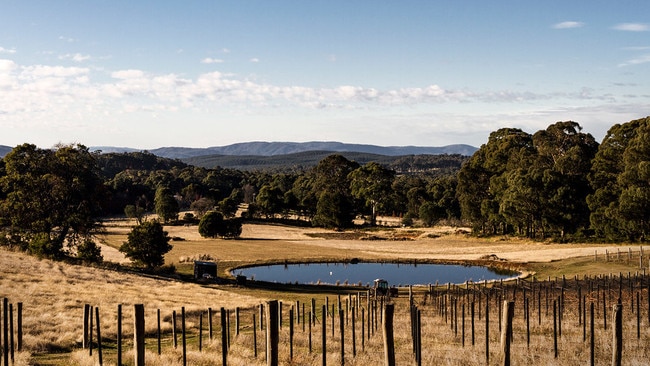Victorian vignerons stocked in world’s best restaurants
Some of the world’s top restaurants are turning to small Aussie producers to fill their patrons’ glasses – and there is the demand to back it up.

Ask the sommelier at leading restaurants such as Eleven Madison Park in New York or L’Osier in Tokyo to recommend a medium-bodied pinot noir and he might point you to a wine from a familiar region: the Macedon Ranges, Victoria. The accompanying name is likely less familiar: Joshua Cooper, a 34-year old rising-star regional winemaker, who specialises in elegant, characterful wine that while unique, are classics to the trained palate.

Cooper isn’t alone. Some of the world’s leading Michelin-starred restaurants are looking to add variety to their lists by seeking out young, experimental Aussie winemakers – many of whom have gone under the radar on home soil.
Artisanal producers like Patrick Sullivan, Tessa Brown, Jeremy Schmölzer and Joshua Cooper are all experiencing their moment in the sun abroad, stocked by the likes of The Fat Duck in Berkshire, UK, and reputable in-the-know wine bars in Copenhagen and France.
So why is it that these winemakers are being celebrated abroad and remain largely unknown at home?

Cooper is one of Australia’s most promising young winemakers. Son of Alan and Nelly Cooper, the husband-wife duo behind Cobaw Ridge, Cooper was practically raised on fine wine. Since being crowned Gourmet Traveller Wine’s Young Winemaker of the Year in 2020, Cooper’s pinot noir and chardonnay has been in demand abroad. He currently exports to 15 countries and says that “most of it goes through Michelin-starred restaurants.”
Cooper’s wines can be found at L’Osier, Tokyo’s three-Michelin starred restaurant led by Taku Iguro, who he describes as “Japan’s best sommelier.” ‘Doug’s Vineyard’ pinot noir was introduced to the wine list at Eleven Madison Park in New York City, making it the first Australian wine ever poured by the glass in Daniel Humm’s acclaimed venue.
“The wines I produce are a modern reinterpretation of classic styles,” says Cooper, who has “an eye to the future as well as the past.”

The shift in direction to smaller, experimental winemakers is far more that a momentary trend; it is emblematic of a broader shift in worldwide taste and what is deemed a pair-worthy wine alongside the best cooked meals in the world.
“Overseas markets have come out the other end of the popularity of Parker and ‘critter’ wines,” says Cooper, referring to the heavily extracted, high-alcohol wines preferred by critic Robert Parker Jr., whose word became gospel for millions around the world, shaping the palate of a generation. Affordable labels such as Yellow Tail earned the nickname of ‘critter wines’ thanks to the animals that appear on their bottles.
-
Patrick Sullivan would consider himself a farmer before a winemaker. With a deep focus on growing his own fruit, Sullivan produces natural wines that celebrate the individual character of a vineyard. He takes fruit from each of his parcels in the region and bottles them separately to show the unique terroir of each of his sites. Compared to mass-produced options, his wine emphasises the variety of vintage, reflecting the ups and downs of winemaking.
A somewhat maverick decision in the world of big-business viticulture, Sullivan’s way of thinking is the perfect match for the weird and wonderful Danish natural wine scene, where his bottlings can be found littered across the capital of Copenhagen in small but buzzing bars like Pompette — where he shares the list with the likes of Daniel Sage, Jean-Francois Ganevat, and other respected names in European natural wine.

Also standing shoulder-to-shoulder with European talent are Tessa Brown and Jeremy Schmölzer of – The duo were spotted early by Heston Blumenthal’s team at The Fat Duck in Bray, Berkshire, England.
In the couple’s second vintage, 48 of their first 60 bottles across three varietals were snapped by the experimental restaurant. It was considered to be the ideal accompaniment to some of Blumenthal’s most out-there dishes such as ‘meat fruit’, which consists of chicken liver and foie gras parfait masterfully encased inside a ‘peel’ of mandarin jelly.
Schmölzer and Brown’s winery is located in Beechworth, Victoria, where the pair make modern and precise styles of riesling, shiraz, and pinot noir. However, it was their chardonnay that caught the attention of Blumenthal’s team, and remains on the list today. Compared with the bold and ‘buttery’ style of chardonnay made popular in America, but adored by some Australians, their take is instead more exact and mineral-driven. The delicate flavours and more elegant profile are highlighted in the wines’ ability to play along with the flavours of the food served with it, rather than to overpower those flavours.

Importers across Europe, the Americas and in Japan are finding serious value and versatility in what can only be described as a new standard for Australian wine.
These wines bear no resemblance to the overworked or manufactured creations that Australia was once known for exporting. They are classic enough to appeal to those who appreciate fine winemaking, and have a sense of complexity that also resonates with the new-age epicurean.
The question is, how can we keep more to ourselves?

To join the conversation, please log in. Don't have an account? Register
Join the conversation, you are commenting as Logout